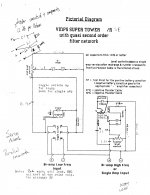What happens to the 12 inch if I remove the 15 inch woofer from this circuit?
My question primarily revolves around the 22 ohm resistor? Does its value need to change?
I'm removing the 15 from this crossover network to drive it w a sep. amp that will have an active crossover.
Thanks
Rick
My question primarily revolves around the 22 ohm resistor? Does its value need to change?
I'm removing the 15 from this crossover network to drive it w a sep. amp that will have an active crossover.
Thanks
Rick
Attachments
Looks to me like the 22 ohm resistor is there to attenuate the 12" speaker.
For what you plan to do, I would remove it.
I'm curious as to the power rating this resistor has.
For what you plan to do, I would remove it.
I'm curious as to the power rating this resistor has.
They are not acoustically coupled, the 12 is actually an 8 in real life and its in a separate chamber inside the speaker cabinet. I think both drivers in question are 8 ohm. The overall goal is to bi-amp the speakers with d class amp driving the 15's and a AB class driving the rest of the drivers. A miniDSP HD will be the active crossover/DSP/room correction.
Last edited:
This is a series crossover. Removing one driver will affect all 4. This doesn't just mean for their basic level, but for variations they have in their impedance.
OK work with me, I'm not to educated in this stuff. if I remove the 15 and the 22 ohm resistor as suggested, will the rest this crossover work ok? If not what do I need to do to make it work ok?
It will work.
Will it be similar, better or worse, it's hard to say. How far is it from correct now, meaning how much is the fussing even necessary, again hard to say.
One approach would be to take a measurement of the 12 and a 5, this must be the kind of measurement appropriate to making filter comparisons only. It could either be made on the speaker terminals or with a mic in front of the speaker. You then remove the 15 and compare. Then you try to compensate by altering the network.
Another approach is ignore the issue, make use of the level control on the two fives, and your active levels, then convert to your active setup. This may be ok, but if you find you don't like it you'll either have to tweak it by hand or you can change it back for the tests, or..
Preferably redo the crossover from scratch.
Will it be similar, better or worse, it's hard to say. How far is it from correct now, meaning how much is the fussing even necessary, again hard to say.
One approach would be to take a measurement of the 12 and a 5, this must be the kind of measurement appropriate to making filter comparisons only. It could either be made on the speaker terminals or with a mic in front of the speaker. You then remove the 15 and compare. Then you try to compensate by altering the network.
Another approach is ignore the issue, make use of the level control on the two fives, and your active levels, then convert to your active setup. This may be ok, but if you find you don't like it you'll either have to tweak it by hand or you can change it back for the tests, or..
Preferably redo the crossover from scratch.
Last edited:
OK I have a UMIK-1 so I can do the measure and compare before and after and see if I can fix the result in the DSP. If not I guess I'll be back someday asking for help designing a new crossover. Now to get into the speakers and do the rewiring....I built them from kits many years ago and the drivers are siliconed in and a real pain to get out.
If there is significant altered interaction between the 12 and the 5s, you won't be able to fix this with any DSP that is crossing them as a set to the 15. The measurements I suggested are specifically needed to keep the 12 and 5s together.
See how it goes and we can discuss how to measure this as an alternative to a full redo.
See how it goes and we can discuss how to measure this as an alternative to a full redo.
- Home
- Loudspeakers
- Multi-Way
- Crossover question: What happens to 12 if I remove the 15
